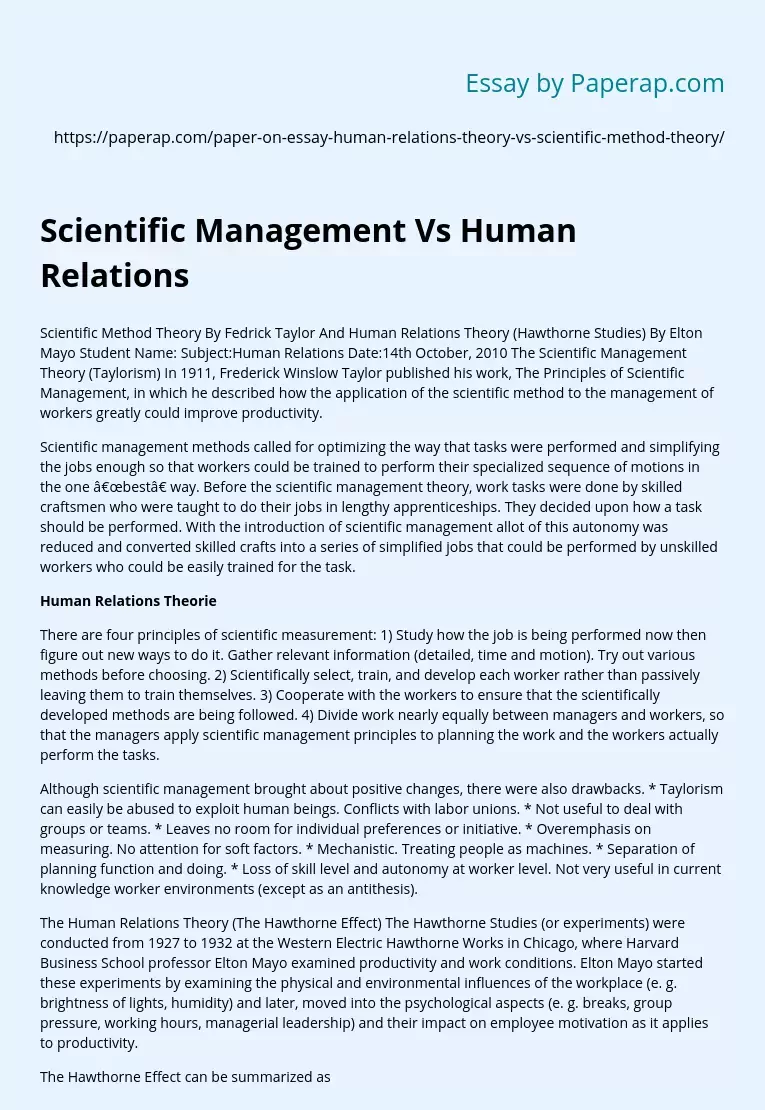Scientific Management Vs Human Relations
Scientific Method Theory By Fedrick Taylor And Human Relations Theory (Hawthorne Studies) By Elton Mayo Student Name: Subject:Human Relations Date:14th October, 2010 The Scientific Management Theory (Taylorism) In 1911, Frederick Winslow Taylor published his work, The Principles of Scientific Management, in which he described how the application of the scientific method to the management of workers greatly could improve productivity.
Scientific management methods called for optimizing the way that tasks were performed and simplifying the jobs enough so that workers could be trained to perform their specialized sequence of motions in the one “best” way.
Before the scientific management theory, work tasks were done by skilled craftsmen who were taught to do their jobs in lengthy apprenticeships. They decided upon how a task should be performed. With the introduction of scientific management allot of this autonomy was reduced and converted skilled crafts into a series of simplified jobs that could be performed by unskilled workers who could be easily trained for the task.
Human Relations Theorie
There are four principles of scientific measurement: 1) Study how the job is being performed now then figure out new ways to do it. Gather relevant information (detailed, time and motion). Try out various methods before choosing. 2) Scientifically select, train, and develop each worker rather than passively leaving them to train themselves. 3) Cooperate with the workers to ensure that the scientifically developed methods are being followed. 4) Divide work nearly equally between managers and workers, so that the managers apply scientific management principles to planning the work and the workers actually perform the tasks.
Although scientific management brought about positive changes, there were also drawbacks. * Taylorism can easily be abused to exploit human beings. Conflicts with labor unions. * Not useful to deal with groups or teams. * Leaves no room for individual preferences or initiative. * Overemphasis on measuring. No attention for soft factors. * Mechanistic. Treating people as machines. * Separation of planning function and doing. * Loss of skill level and autonomy at worker level. Not very useful in current knowledge worker environments (except as an antithesis).
The Human Relations Theory (The Hawthorne Effect) The Hawthorne Studies (or experiments) were conducted from 1927 to 1932 at the Western Electric Hawthorne Works in Chicago, where Harvard Business School professor Elton Mayo examined productivity and work conditions. Elton Mayo started these experiments by examining the physical and environmental influences of the workplace (e. g. brightness of lights, humidity) and later, moved into the psychological aspects (e. g. breaks, group pressure, working hours, managerial leadership) and their impact on employee motivation as it applies to productivity.
The Hawthorne Effect can be summarized as “Employees are more productive because the employees know they are being studied. ” Elton Mayo’s experiments showed an increase in worker productivity was produced by the psychological stimulus of being singled out, involved, and made to feel important. Specifically, Mayo wanted to find out what effect fatigue and monotony had on job productivity and how to control them through such variables as rest breaks, work hours, temperature and humidity. In the process, he stumbled upon a principle of human motivation that would help to revolutionize the theory and practice of management.
To his amazement, Elton Mayo discovered a general upward trend in production, completely independent of any of the changes he made. Flowing from the findings of these investigations he came to certain conclusions as follows: * Work is a group activity. * The social world of the adult is primarily patterned about work activity. * The need for recognition, security and sense of belonging is more important in determining workers’ morale and productivity than the physical conditions under which he works. A complaint is not necessarily an objective recital of facts; it is commonly a symptom manifesting disturbance of an individual’s status position. * The worker is a person whose attitudes and effectiveness are conditioned by social demands from both inside and outside the work plant. * Informal groups within the work plant exercise strong social controls over the work habits and attitudes of the individual worker. * The change from an established society in the home to an adaptive society in the work plant resulting from the use of new techniques tends continually to disrupt the social organization of a work plant and industry generally. Group collaboration does not occur by accident; it must be planned and developed. If group collaboration is achieved the human relations within a work plant may reach a cohesion which resists the disrupting effects of adaptive society. Difference of the two theories Frederick Winslow Taylor and George Elton Mayo carried out an enormous amount of research and made a substantial contribution in this area. However, although their initial aims were very similar – to improve productivity, their methods and conclusions were very different.
Taylor theory of Scientific Management study included his time and motion studies, his idea of ‘one best way’ to perform a job and ‘one best’ person to perform it, the fact that he thought people were primarily motivated by money, and the effects all of this would have on employees. Mayo initially seeked to prove Taylor’s theories right, however, due to the Hawthorne Experiments, he became more interested in the involvement and fair treatment of workers and their social environment. He found that people weren’t just motivated by money.
The main difference between the two theories is that Taylor’s studies concentrated mostly on work organization e. g. efficiency while Mayo’s theory seeked the interest of more personal or human related aspects in the organization.
Reference 1. http://www. netmba. com/, James E. Gurun, Fenghua Wang, Patrick R. Barton, Copyright © 2002-2010 This web site is operated by the Internet Center for Management and Business Administration, Inc. 2. http://www. change. freeuk. com/learning/business/mayo. html Adrian Worsfold 3. www. wikipedia. com , Wikipedia®
Scientific Management Vs Human Relations. (2019, Dec 05). Retrieved from https://paperap.com/paper-on-essay-human-relations-theory-vs-scientific-method-theory/

